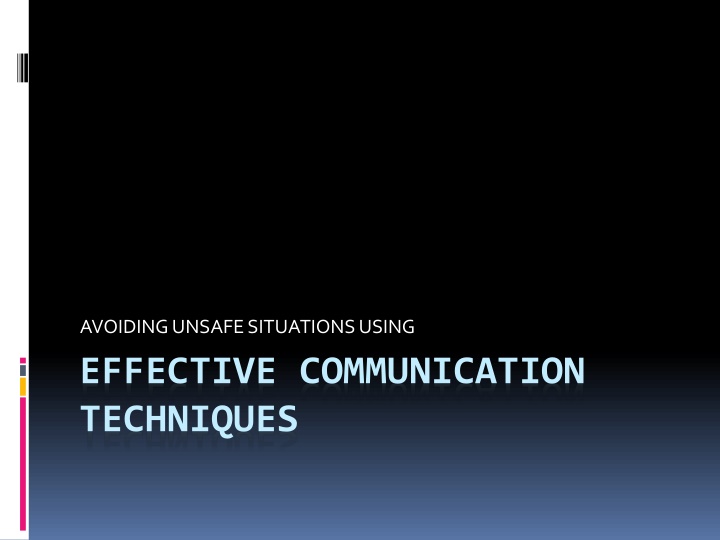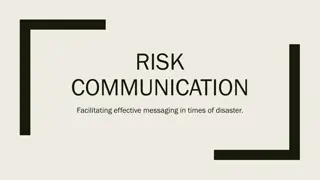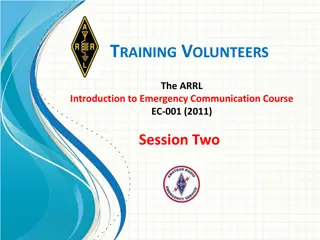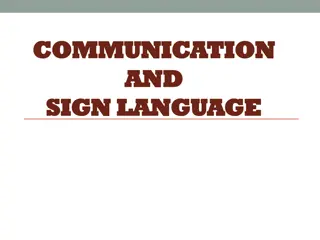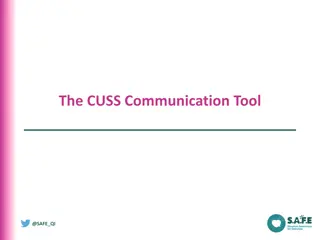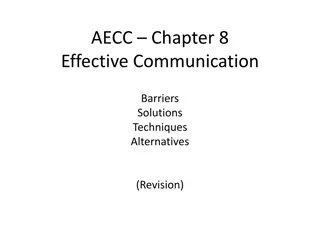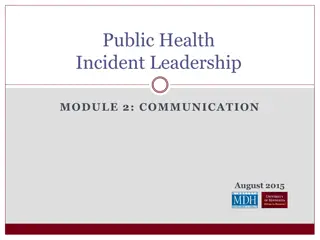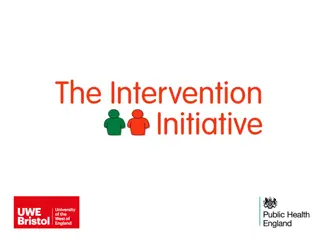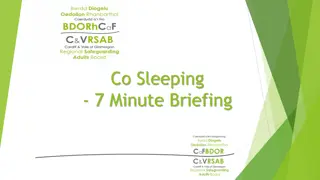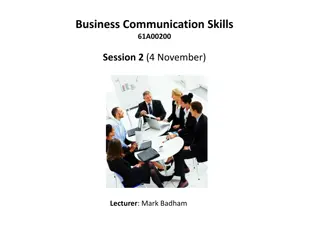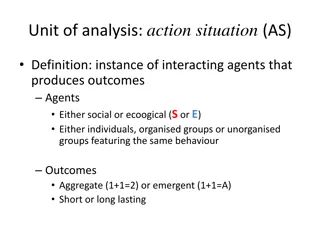Effective Communication Techniques for Avoiding Unsafe Situations
Recognize communication danger signs, prevent escalation, and communicate effectively in tense situations. Understand the basics of dynamic communication, sender-receiver dynamics, and instances where tensions arise. Prioritize safety by de-escalating agitated individuals, considering risk factors for violence, and recognizing warning signs of personal threat. Trust your instincts in challenging situations.
Download Presentation

Please find below an Image/Link to download the presentation.
The content on the website is provided AS IS for your information and personal use only. It may not be sold, licensed, or shared on other websites without obtaining consent from the author.If you encounter any issues during the download, it is possible that the publisher has removed the file from their server.
You are allowed to download the files provided on this website for personal or commercial use, subject to the condition that they are used lawfully. All files are the property of their respective owners.
The content on the website is provided AS IS for your information and personal use only. It may not be sold, licensed, or shared on other websites without obtaining consent from the author.
E N D
Presentation Transcript
AVOIDING UNSAFE SITUATIONS USING EFFECTIVE COMMUNICATION TECHNIQUES
OBJECTIVES Recognize communication danger signs Take steps to prevent escalation Apply skills to communicate effectively in tense situations
BASIC COMMUNICATION Process exchanging facts or ideas between persons Dynamic, not static and can be affected by many variables (environment, tone, approach, clarity, style )
Communication Sender Receiver
Instances where communications can become tense Staff/family conflicts Conflicts within families (separations/divorces, financial and other stresses on families)
SAFETY FIRST! IF A PERSON IS BECOMING AGITATED (ESCALATING): ASK YOURSELF IF YOU FEEL YOU ARE IN PHYSICAL DANGER Time to implement the crisis plan! Assume the worst Isolate Call for help Call 911(?) Crowd control Physical environment Escape route / exit Personal space Use de-escalation techniques Check out yourself Check out the environment Work on non-verbal communication Verbal de-escalation IF YES IF NO
Risk factors for violence Past history of violence Suicidal tendencies Med compliance /changes Substance abuse Patterns Triggers, e.g. divorce Demographic factors
How do you know when you are being personally or physically threatened? You will know it when it happens to you. You will feel it. Trust your instincts
Warning Signs The person s emotions are escalating They may be using words to put you down or invalidate you They may not respond at all (avoidance/withdrawal) They repeat back what you say in a negative way (not the way you meant it)
Verbal De-Escalation Some Tactics are: Simply listening Distracting the other person Re-focusing the other person on something positive Changing the subject Use humor (sparingly) to lighten the mood (be very careful with this!) Motivating the other person Empathizing with the other person Giving choices Setting limits
De-Escalation Techniques Remember the intent is to calmly bring the level of anger to a safer place Do not get loud and try to yell over a screaming person Wait until the individual takes a breath, then talk Speak calmly and at an average volume Respond selectively Answer all informational question, no matter how rudely asked Ex: Why do I have to fill out these (expletive) forms? This is a real, information seeking question Do NOT answer abusive questions Ex: Why are you being such an (insult)? This question should get no response whatsoever
De-Escalation techniques con t Explain limits and rules in a firm but respectful tone Give choices where possible in which both alternatives are safe ones Ex: Would you like to calmly continue this conversation now or would you prefer to stop and discuss it later when we can be more relaxed? Empathize with feelings but NOT with the behavior Ex: I understand that you feel angry, but it is not okay for you to yell at me. Do NOT argue or try to convince Suggest alternative behaviors where appropriate Ex: Would you like to take a break from this discussion ? We can continue when it is a better time for you. Give the consequences of inappropriate behavior without threats or anger Ex: I want to be able to help you, but I need you not to yell at me
De-escalating Effectively To verbally de-escalate another person, you must open as many clear lines of communication as possible. Both you and the other person must listen to each other and have no barriers. Barriers to Communication are the things that keep the meaning of what is being said from being heard. Communication Barriers: Pre-judging Not Listening Criticizing Name-Calling Engaging in Power Struggles Ordering Threatening Minimizing Arguing
De-escalating Positively Use positive and helpful statements such as: I want to help you! Please tell me more so I better understand how to help you. Let s call Mr. Smith [staff member or resource] I know he would be able to help with this let s ask [another staff member] what she thinks about this situation She is always willing to help! Put yourself on his/her side of finding a solution to the problem.
Be an empathetic listener Do NOT be judgmental. Do NOT ignore the person or pretend to be paying attention. Listen to what the person is really saying. Re-state the message. Clarify the message. Repeat the message. Be empathetic! Validate -- I understand why (Not in agreement with ) Try to establish rapport with the other person.
Body Language Finger pointing may seem accusing or threatening. Shoulder shrugging may seem uncaring or unknowing. Rigid walking may seem unyielding or challenging. Jaw set with clenched teeth shows you are not open- minded to listening to his/her side of the story. A natural smile is good. A fake smile can aggravate the situation. Use slow and deliberate movements -- quick actions may surprise or scare the other person.
Personal Space Invasion or encroachment of personal space tends to heighten or escalate anxiety. Note: Personal space is usually 1.5 to 3 feet -- far enough away so you cannot be hit or kicked. Do not touch a hostile person -- they might interpret that as an aggressive action. Keep your hands visible at all times -- you do not want the other person to misinterpret your physical actions.
Use of your voice Tone Volume Rate of speech Inflection of voice
Tone of your voice A lowered voice level may set a tone of anger which could create fear or challenges. A raised voice may set a tone of anticipation or uncertainty which may promote excitement or disruption. Speak slowly -- This is usually interpreted as soothing. A controlled voice is one of calm and firmness which promotes confidence in both parties. Humor may unintentionally offend someone and escalate the situation. -- Use humor sparingly and always direct humor toward yourself. (Be very careful when attempting humor in this type of situation!) Always be respectful to the other person. Using please and thank-you -- Mr or Ms indicates respect.
Tips Remain calm -- Listen - really listen! Avoid overreaction. Validate! I understand why you might be upset. (This does not indicate that you agree with them.) Remove onlookers -- or relocate to a safer place. (Onlookers can become either cheerleaders or additional victims.) Send an onlooker for help. Watch for non-verbal clues or threats. Bring in another trained person to assist whenever possible. There is less chance of aggressive behavior if two people are talking to one person.
Ask for Help! Alert someone else as soon as possible. (No help will arrive until someone else knows your situation. Until then, you are all alone.) Two heads are always better than one. There is safety in numbers. It will be beneficial to have a witness, if the situation deteriorates and someone is injured.
Things NOT to do! Avoidbecoming emotionally involved -- control your emotions at all times. Avoid engaging in power struggles. Avoid becoming rigid in your process. Avoid telling the other person that you know how he or she feels. Avoid raising your voice, cussing, making threats, and giving ultimatums or demands. Avoid aggressive language, including body language. Do not attempt to intimidate a hostile person.
Good Communication I-statements and XYZ statements vs. You- always statements Paraphrasing Perception Checking Avoid negative reciprocity Validate ( I don t blame you for feeling that way, I understand that )
Practice the skills In daily encounters which are not threatening Model good communication skills and conflict resolution for the kids (the xyz statements)
What should I do if there is an intruder? Many people don t want to think about this possibility, but the best itme to think about it is before it happens
How Do I respond The best way to respond will depend on where you are, how close the intruder is, and whether they know you are there.
If you can Leave do so If you an alarm, you will know immediately, don't wait to see if it a family member that forgot to enter the security code. If you are near a door and can safely exit without the intruder seeing you, make a run for it. Don t stop to grab anything
If you cant leave hide Retreat to a room or closet that has a locking door from the inside, barricade the door and call 911. If you don t have a cell phone then wait quietly for the intruder to complete the robbery and leave. Create a safe room in your building and make sure all know where it is, and that it locks from within, can have a extra phone or phone charger in there along with a bat or weapon
If intruder confronts you Try and remain calm and raise your hands to your shoulder height. This will allow you to move quickly if you need to defent yourself. Speak in a calm low voice and do not make eye contact
Be prepared with a plan Choose and exit for each of the possible intruder points of entry, and make sure all in the building knows the exits Create a safe room with phone, charger and blankets, and keep quite Share the plan with all and run through your safety plan Practice your plan. Maybe create a code word to let all know there is an intruder
